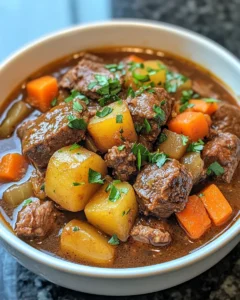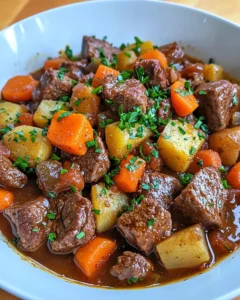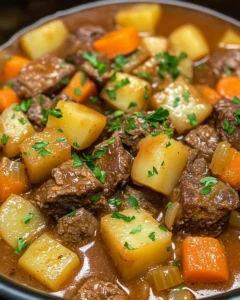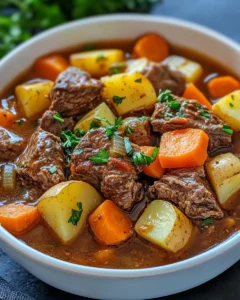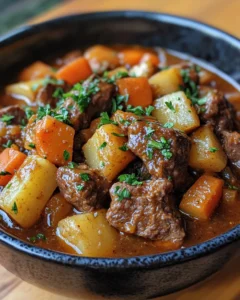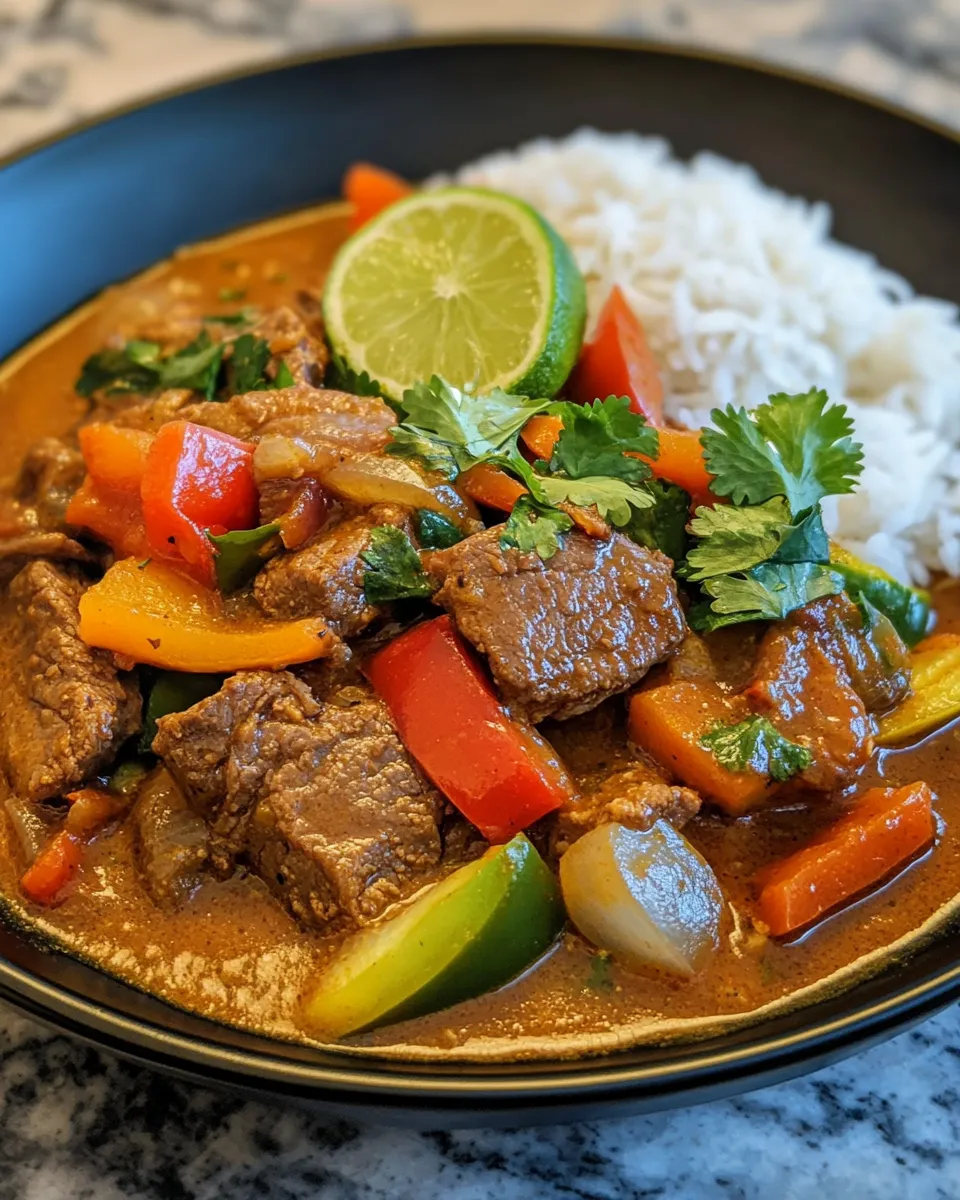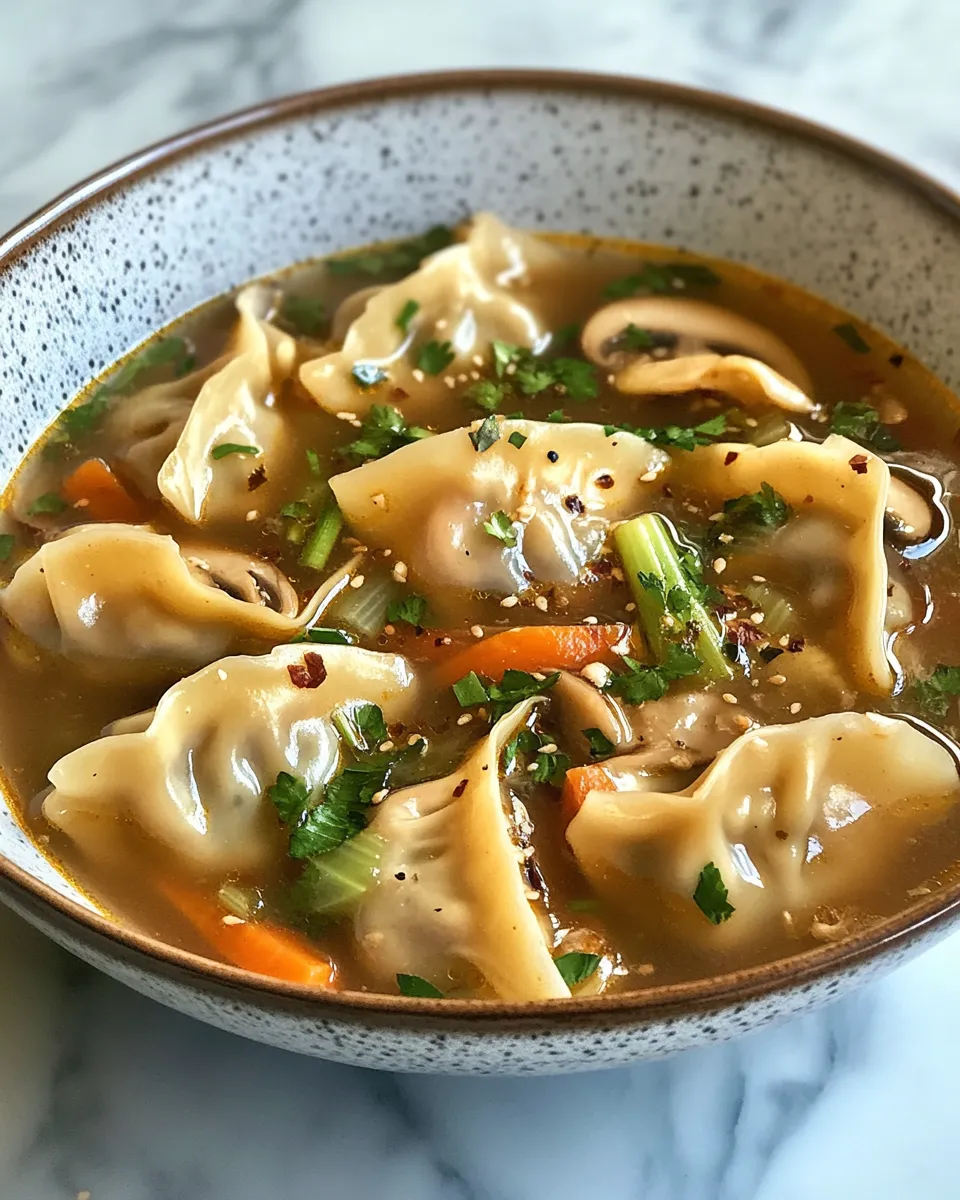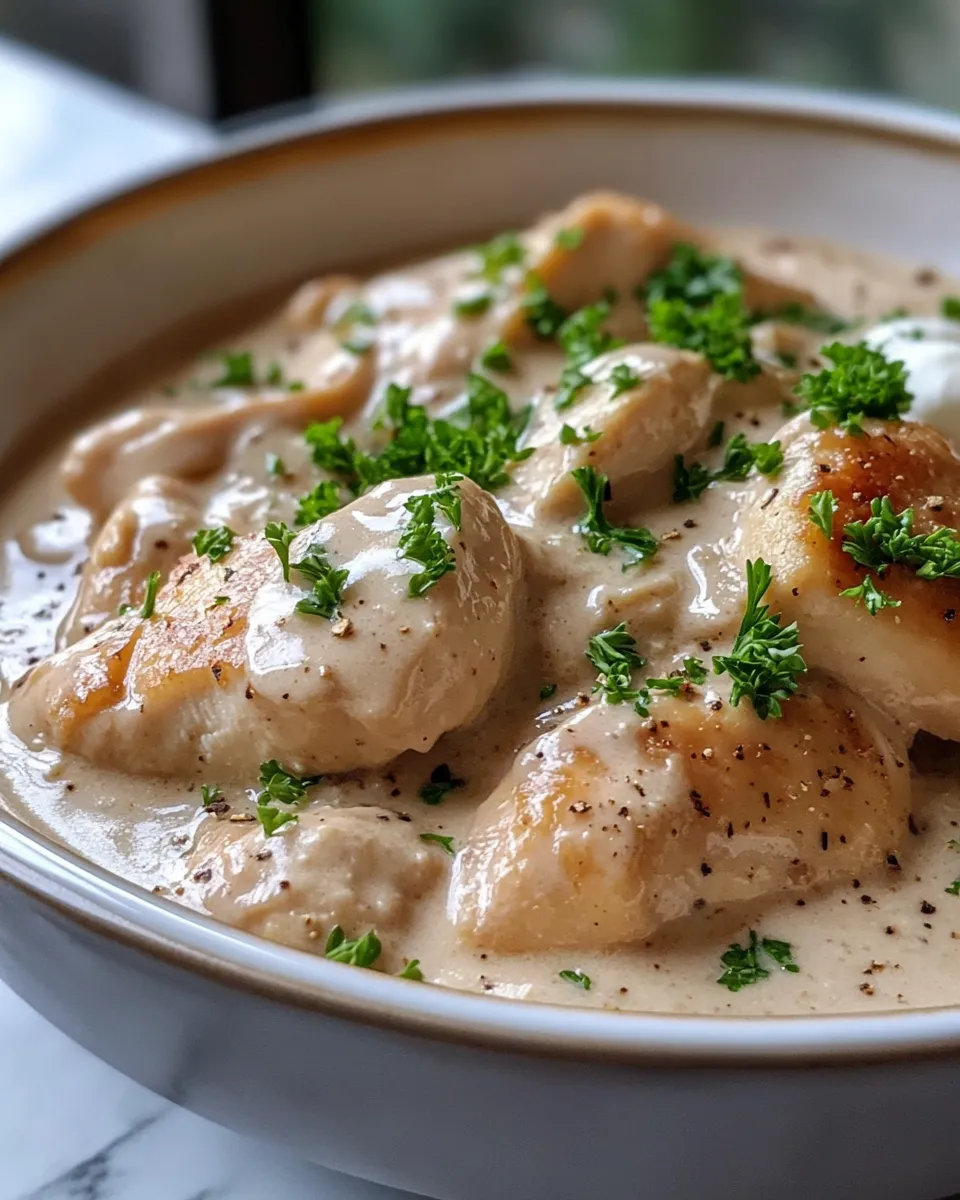There’s nothing quite like the comforting aroma of a hearty beef stew simmering away in the kitchen. As the weather cools down and the days grow shorter, we naturally crave meals that warm us from the inside out. This Slow Cooker Harvest Beef Stew is exactly that kind of dish. With tender beef, earthy root vegetables, and a rich, savory broth, it’s the perfect meal for cozy family dinners, busy weeknights, or even holiday gatherings.
The inspiration for this recipe comes from the heart of autumn harvest traditions. For generations, families have gathered around the table with stews that celebrate the season’s bounty. Using the slow cooker makes it even easier to bring this tradition into your own kitchen, turning humble ingredients into something memorable and deeply satisfying.
Why You’ll Love This Recipe
- Effortless preparation: Toss everything into the slow cooker and let it work its magic.
- Perfect for busy days: Set it in the morning and come home to a complete meal.
- Seasonal flavors: Root vegetables, herbs, and tender beef bring autumn comfort to your table.
- Family-friendly: This stew is hearty, wholesome, and loved by kids and adults alike.
- Great for leftovers: The flavors deepen overnight, making it even better the next day.
Ingredients You’ll Need
Here’s everything you’ll need to make a flavorful pot of Slow Cooker Harvest Beef Stew:
- Beef chuck roast (about 2 pounds, cut into bite-sized cubes)
- Carrots (3–4 medium, peeled and sliced)
- Potatoes (3 medium, cut into chunks)
- Parsnips (2, peeled and sliced)
- Celery (2 stalks, chopped)
- Onion (1 large, diced)
- Garlic (3 cloves, minced)
- Tomato paste (2 tablespoons)
- Beef broth (4 cups)
- Diced tomatoes (1 can, 14.5 oz)
- Bay leaves (2)
- Fresh thyme (2–3 sprigs) or 1 teaspoon dried thyme
- Fresh rosemary (1 sprig) or 1 teaspoon dried rosemary
- Salt and black pepper (to taste)
- Olive oil (2 tablespoons, for browning the beef)
- Cornstarch slurry (2 tablespoons cornstarch mixed with 2 tablespoons water, optional, for thickening)
Step-by-Step Instructions
Step 1: Brown the Beef
One of the secrets to creating a truly flavorful beef stew is taking the time to brown the meat before it goes into the slow cooker. While the slow cooker will tenderize the beef during its long simmer, it won’t give you that deep, savory flavor that comes from browning. Begin by heating two tablespoons of olive oil in a heavy-bottomed skillet over medium-high heat. Once the oil shimmers, add a portion of the beef cubes, making sure not to overcrowd the pan. Overcrowding leads to steaming instead of searing, which diminishes the flavor payoff. Allow the beef to cook undisturbed for a couple of minutes before turning, letting each side develop a rich, caramelized crust. Work in batches until all the meat is browned, then transfer the beef to the slow cooker. You’ll notice that the skillet has a layer of browned bits on the bottom—those bits are pure flavor and will be deglazed later into the stew.
Step 2: Prepare the Vegetables
While the beef is searing, you can multitask by prepping the vegetables. Wash, peel, and chop the carrots into bite-sized pieces. Cut the potatoes into hearty chunks so they don’t disintegrate during the long cooking process. Peel and slice the parsnips for a slightly sweet, earthy flavor that complements the beef. Dice the onion and chop the celery for aromatic depth, and finally, mince three cloves of garlic for a punch of sharp, savory flavor. Layer all these vegetables directly into the slow cooker, creating a colorful and hearty base that will soak up the flavors of the broth and herbs as they cook slowly throughout the day.
Step 3: Build the Base
With the beef and vegetables in place, it’s time to add the flavorful liquid that ties everything together. Stir in two tablespoons of tomato paste, which not only deepens the color of the stew but also adds a concentrated richness. Next, pour in a can of diced tomatoes, juice included, for a slight acidity that balances the richness of the beef. Add four cups of beef broth, which provides the savory foundation for the stew. Drop in two bay leaves, sprigs of thyme, and rosemary for fresh herbal notes that infuse the stew as it cooks. Season generously with salt and black pepper, remembering that seasoning at this stage builds layers of flavor as the ingredients meld together over the long cooking time.
Step 4: Slow Cook to Perfection
This is the step where the magic happens. Place the lid on the slow cooker and set it to low for 7–8 hours or high for 4–5 hours, depending on your schedule. As the hours pass, the beef slowly tenderizes, transforming from tough cubes into fork-tender bites that practically melt in your mouth. The vegetables soften, but they retain enough structure to give the stew body. The broth thickens slightly as it absorbs the starches from the potatoes, becoming a flavorful sauce that clings to every spoonful. Your kitchen will fill with the irresistible aroma of herbs, beef, and simmering vegetables, creating a comforting atmosphere that makes waiting for dinner all the more rewarding.
Step 5: Thicken the Stew (Optional)
Some people prefer their beef stew with a brothy consistency, while others love it thick and hearty. If you fall into the second category, this is where you can customize the texture. About 30 minutes before serving, whisk together two tablespoons of cornstarch with two tablespoons of cold water to create a slurry. Stir this mixture into the stew, replace the lid, and allow it to cook until the liquid thickens. The result will be a silky, luscious broth that clings to every piece of beef and vegetable. Alternatively, you could mash a few potato chunks directly into the stew for a more rustic thickening method.
Step 6: Serve and Enjoy
Once the stew is cooked and perfectly thickened (if desired), remove the bay leaves and any herb stems. Give the stew a final taste test, adjusting salt and pepper to suit your preference. Ladle generous portions into bowls and serve hot. Pair it with crusty bread for dipping, soft dinner rolls, or even fluffy biscuits. For a lighter touch, a fresh green salad on the side balances the richness of the stew. This hearty dish is more than just a meal—it’s comfort in a bowl, the kind of recipe that warms both body and soul on chilly evenings. Leftovers reheat beautifully, making it just as enjoyable the next day.
Tips for the Best Slow Cooker Harvest Beef Stew
- Choose the right beef: Chuck roast is ideal because it becomes tender and flavorful when slow-cooked.
- Don’t skip browning: While optional, searing the beef adds caramelization that elevates the flavor.
- Use hearty vegetables: Root veggies like carrots, potatoes, and parsnips hold their texture well.
- Layer flavors: Fresh herbs like thyme and rosemary make a big difference.
- Make it ahead: The stew tastes even better the next day, so don’t hesitate to prepare it in advance.
Ingredient Swaps and Variations
- Vegetables: Swap parsnips with sweet potatoes, turnips, or butternut squash.
- Protein: Use lamb or chicken thighs for a different twist.
- Seasoning: Add paprika, Italian seasoning, or a pinch of cayenne for extra warmth.
- Broth: Vegetable broth works if you want a lighter base.
- Gluten-free: This stew is naturally gluten-free. Just ensure your broth and tomato paste are certified gluten-free.
What to Serve with Beef Stew
This Slow Cooker Harvest Beef Stew is hearty enough to be a standalone dish, but pairing it with the right side makes the meal even more satisfying:
- Crusty bread or dinner rolls – Perfect for soaking up the flavorful broth.
- Mashed potatoes – Serve the stew over a bed of creamy potatoes.
- Steamed rice – A simple side that absorbs the stew’s rich flavors.
- Salads – A crisp green salad balances the heartiness of the stew.
Storage and Reheating Instructions
- Refrigerator: Store cooled stew in an airtight container for up to 4 days.
- Freezer: Freeze in freezer-safe containers for up to 3 months.
- Reheating: Warm on the stovetop over medium heat, or reheat individual portions in the microwave.
Frequently Asked Questions
1. Can I skip browning the beef?
Technically, yes—you can place the raw beef straight into the slow cooker without searing it first. However, browning the beef is a highly recommended step if you want maximum flavor. When you sear beef in a hot skillet, the surface undergoes caramelization, known as the Maillard reaction, which creates a deep, savory taste that slow cooking alone cannot achieve. Skipping this step won’t ruin the dish, but it will result in a stew with a milder flavor profile. If you’re short on time, you can skip it, but whenever possible, take those few extra minutes to brown the meat—you’ll notice the difference in the final bowl.
2. Can I cook this on the stovetop instead?
Yes, you can easily adapt this slow cooker recipe to a stovetop version. A large Dutch oven or heavy-bottomed pot works perfectly for this method. Start by browning the beef just as you would for the slow cooker, then add the vegetables, broth, tomatoes, and seasonings. Bring everything to a gentle simmer, cover the pot, and cook over low heat for about 2–3 hours. Stir occasionally to prevent sticking and to ensure the flavors are well blended. The stovetop version may require more attention than the slow cooker, but it still yields tender beef and rich, flavorful broth.
3. How do I thicken the stew without cornstarch?
Cornstarch is a quick and easy way to thicken stew, but there are several alternatives. You can use a few tablespoons of all-purpose flour, whisked into a little water before adding to the stew. Another option is to mash some of the potatoes or other root vegetables directly in the pot, which naturally thickens the broth while adding a rustic texture. If you prefer, simply remove the lid during the last 30 minutes of cooking to allow some liquid to evaporate, reducing the broth into a slightly thicker consistency. Each method offers a different result, so you can choose based on the texture you enjoy most.
4. Can I add frozen vegetables?
Yes, frozen vegetables can be a convenient addition, but timing matters. If you add them at the beginning of cooking, they will likely become overly soft and lose their texture by the time the stew is ready. To avoid this, add frozen peas, green beans, corn, or mixed vegetables during the last hour of cooking. This way, they warm through and maintain their color, flavor, and texture without turning mushy. Frozen vegetables can also add brightness and a touch of sweetness to the finished stew, making them an excellent way to customize the recipe.


